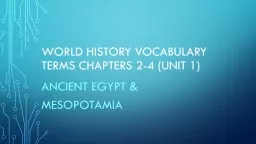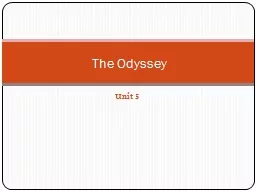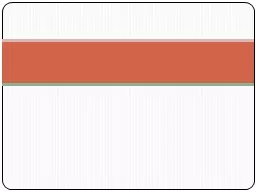PPT-WORLD HISTORY VOCABULARY TERMS Chapters 2-4 (UNIT 1)
Author : alexa-scheidler | Published Date : 2016-06-11
Ancient Egypt amp Mesopotamia RELIGION IN THE REGION Ziggurat a massive stepped tower on which was built a temple dedicated to the chief god or goddess of a
Presentation Embed Code
Download Presentation
Download Presentation The PPT/PDF document "WORLD HISTORY VOCABULARY TERMS Chapters ..." is the property of its rightful owner. Permission is granted to download and print the materials on this website for personal, non-commercial use only, and to display it on your personal computer provided you do not modify the materials and that you retain all copyright notices contained in the materials. By downloading content from our website, you accept the terms of this agreement.
WORLD HISTORY VOCABULARY TERMS Chapters 2-4 (UNIT 1): Transcript
Ancient Egypt amp Mesopotamia RELIGION IN THE REGION Ziggurat a massive stepped tower on which was built a temple dedicated to the chief god or goddess of a Sumerian city Zoroastrianism . Lord of the Flies. Vocabulary. Turn in . LotF. Vocabulary 1. List 2. Bastion. Leviathan. Impervious. Demure. Myopia. Truculently. Inimical. Ensconce. Cordon. Fathom. The Sound of the Shell. “The boy with fair hair lowered himself down the last few feet of rock and began to pick his way toward the lagoon…All round him the long scar smashed into the jungle was a bath of heat” (Golding 7).. Motif . - . A . recurring element, such as a type of incident, a device, . an image, or reference, . which appears frequently . in a work . of literature. .. Symbol. - . a word, place, character, or object that means something beyond what it is on a literal . Test Friday November 4. th. . Unit 6 Vocabulary. Adversary- someone who offers opposition to someone else.. The two teams were . adversaries . of each other.. Ardor- feelings of great warmth and intensity.. Unit 10 Vocabulary. Arbitrate – . act between parties with a view to reconciling differences. . Braggart – . a very boastful and talkative person.. Gossamer – . a gauze fabric with an extremely fine texture.. 9/1. Unit 2 Vocabulary. Exempt (adj.) . - . grant relief from a rule or requirement.. If you do well on your test you may be . exempt . from the final exam.. Dismayed (v.) . - . struck with fear, dread, or consternation.. rd. . Unit 3 Vocabulary . Prohibited- forbidden by law.. Driving drunk is . prohibited. .. Compel- force somebody to do something.. The football coach . compels. the players to practice hard.. Conspicuous- obvious to the mind or eye.. Ch. 1-2. Ch. 3-4. Ch. 5-6. Ch. 7-8. Ch. 9-10. Chapters 1-2. adj. cynical. Definition. Having a low opinion of humanity or disbelief in human goodness; pessimistic, sarcastic. n. tyranny. Definition. th. . Unit 6 Vocabulary. Adversary- someone who offers opposition to someone else.. The two teams were . adversaries . of each other.. Ardor- feelings of great warmth and intensity.. The couple’s . Suitor- a man who courts a woman. .. The father was waiting a proper . suitor. for his daughter. Asunder- into parts or pieces. .. Hurricane Matthew ripped Florida . asunder.. Quell-suppress . or crush completely. th. . Unit 4 Vocabulary. Accentuate- to stress, single out as important.. The girl wanted makeup that would . accentuate . her blue eyes.. Bizarre- conspicuously or grossly unconventional or unusual.. VOCABULARY- CHAPTERS 1-3. Disgrace. . To bring shame to. Aloofness. Removed; distant in interest or feeling. Incredulous. Skeptical. Inability to believe something. VOCABULARY- CHAPTERS 1-3. Roguishly. Unit 13 Vocabulary. Unsullied: . spotlessly clean and fresh.. Atticus’s office in the courthouse contained little more than a hat rack, a spittoon, a checkerboard and an . unsullied. Code of Alabama.. Directions. Complete the vocabulary preview activity for Chapters 11-13.. Remember…read each sentence and define the underlined words as they are used within the text (context clues).. Do this activity NOW!! Do not advance this slide until you are finished with that activity.. Forbidden. (adj.) banned, not allowed. Harry and Ron frequented the “forbidden” section of the library.. Nondescript. (adj.) lacking distinctive characteristics or qualities. The classroom was very nondescript – it lacked posters, colors, and bulletin boards..
Download Document
Here is the link to download the presentation.
"WORLD HISTORY VOCABULARY TERMS Chapters 2-4 (UNIT 1)"The content belongs to its owner. You may download and print it for personal use, without modification, and keep all copyright notices. By downloading, you agree to these terms.
Related Documents














